Tomato hornworm
| Tomato hornworm | |
|---|---|
 |
|
| Manduca quinquemaculata Male - Dorsal | |
 |
|
| Manduca quinquemaculata Male - ventral | |
| Scientific classification | |
| Kingdom: | Animalia |
| Phylum: | Arthropoda |
| Class: | Insecta |
| Order: | Lepidoptera |
| Family: | Sphingidae |
| Genus: | Manduca |
| Species: | M. quinquemaculata |
| Binomial name | |
|
Manduca quinquemaculata (Haworth, 1803) |
|
| Synonyms | |
|
|
Manduca quinquemaculata (five-spotted hawkmoth) is a brown and gray hawk moth of the family Sphingidae. The caterpillar, often referred to as the tomato hornworm, can be a major pest in gardens. Tomato hornworms are closely related to (and sometimes confused with) the tobacco hornworm (Manduca sexta). This confusion arises because caterpillars of both species feed on the foliage of various plants from the family Solanaceae, so either species can be found on tobacco or tomato leaves. Thus, the plant on which the caterpillar is found does not indicate its species.
The larvae of these species can be distinguished by their lateral markings: Tomato hornworms have eight V-shaped white markings with no borders and dark blue or black horns; Tobacco hornworms have seven white diagonal lines with a black border and red horns. The moths can be distinguished by the number of spots on their abdomens, with M. quinquemaculata having, as its name suggests, five. Tomato hornworms grow as large as 4 inches (10 cm) in length, while the adults have a wingspan of 3.5 to 5.3 inches (8.9 to 13.5 cm).
Tomato hornworm larva
Female - Dorsal
Female - △ Ventral
M. quinquemaculata is found throughout the United States, northwestern Mexico, and even southern Canada, but is less frequently found throughout the Great Plains and the southeast.
Tomato hornworms are known to eat various plants from the family Solanaceae, commonly feeding on tomato, eggplant, pepper, tobacco, moonflowers and potato. Accordingly, they are often found on defoliated tomato plants, the caterpillar clinging to the underside of a branch near the trunk. They are difficult to spot due to their green coloration. Tomato hornworms fluoresce differently from tomato leaves. Using an ultraviolet light source of 375 nm and viewed behind a blue-blocking filter (yellow or amber filter), a tomato hornworm fluoresces in bright green while a tomato leaf appears deep red/amber. This sharp color contrast helps gardeners locate tomato hornworms at night. They can be reduced by planting marigold flowers around these plants.
...
Wikipedia
